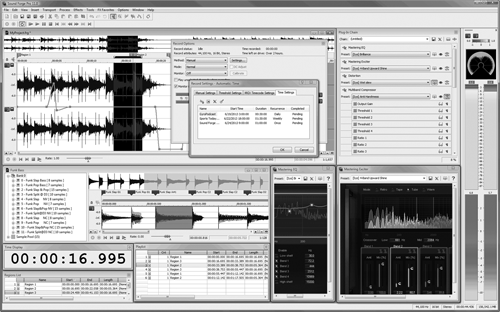
I GOT THE NEWS
For me the most important change is the one that probably appears to be the most frivolous -- that Sony made the recording window modeless. What this means: previous versions used a modal window for the recording functions, which forced users to make and confirm some choice before they could dismiss the window and get on with their work. Now the record window is modeless, so it can be moved about independently of the other windows. This makes it easier to see the waveform develop while recording, and to monitor un-armed channels while recording others. Punch in has been simplified, so you can drop a marker at the in point and select as much or little pre-roll as necessary by entering the amount in the modeless recording window. Yes, it’s a geeky feature, and it could be argued that the modeless window should have been implemented some time ago. But it does make record operations in Forge faster than they were before.
The Plug-In Chain window is also now modeless, allowing you to click away from it at any time to adjust your selection or to apply effects to a different data window without having to close the Chain. Working with the Chain still feels like working with an awkward teenager who knows what I want but just doesn’t feel like helping me get it. But the ability to link up to 32 DirectX and VST plug-ins into a single chain, to preview them all simultaneously in real time (computer processing power permitting) and then to save that chain for later recall more than makes up for the minor inconveniences.
Also making up for minor inconveniences is the new ability to add plug-ins to the audio input bus. This of course implies that you can record wet in Forge Pro 11, for those who are so inclined. In addition to the already extensive list of Sony plug-ins already bundled with Forge Pro 11, iZotope’s well-regarded Nectar Elements vocal processing package is now included in the package, and it would make a good candidate for the Input Bus. Also included as before as are their Declipper, Denoiser and Declicker audio repair and restoration tools. The latter are highly prized by those of us who need to cleanup and enhance audio files, while the former will be useful for those who need to set up a processed VO channel and get the voiceover track recorded, edited and processed.
Forge Pro 11 does comes with a full rack of other features, improvements and updates. For example, you can now work in a project environment within Forge Pro 11. Unlike working with a “project” in Sony’s Vegas, Forge Pro 11’s project file (which comes with an .frg extension) is not a collection of files, but rather a collection of pointers to the source files for the project. Saving a project creates both the .frg file and a folder containing copies of the media files, together with all the temporary files created whilst working on the project. This means that a project can be created, edited and saved without any changes being made to the original source files. Even better, there is also the facility within the project file to undo any past operations, including those occurring before the most recent save point.
Once all editing has been completed, the .frg file is used to render the project’s media files to produce the final output file(s). Saving the project path information with the rendered file means that you can easily return to the source project to make any necessary modifications, should you use that rendered file within another Forge Pro 11 project. If you happen also to be an Acid or Vegas user, embedding project path references means that, should you use a media file from those applications in a Forge Pro 11 project and need to edit it, you can open the source project in its associated application directly from Forge Pro 11 via the Edit Source Project shortcut menu.
Although this is not a new feature, it is worth noting that the ability to save the entire on-screen layout as a Sound Forge Workspace .sfw file allows you to recall complex editing scenarios with all file windows restored to their previous sizes, magnification and positions on reopening. Cursor positions, custom views and the plug-ins in the Plug-In Chain are also restored.

